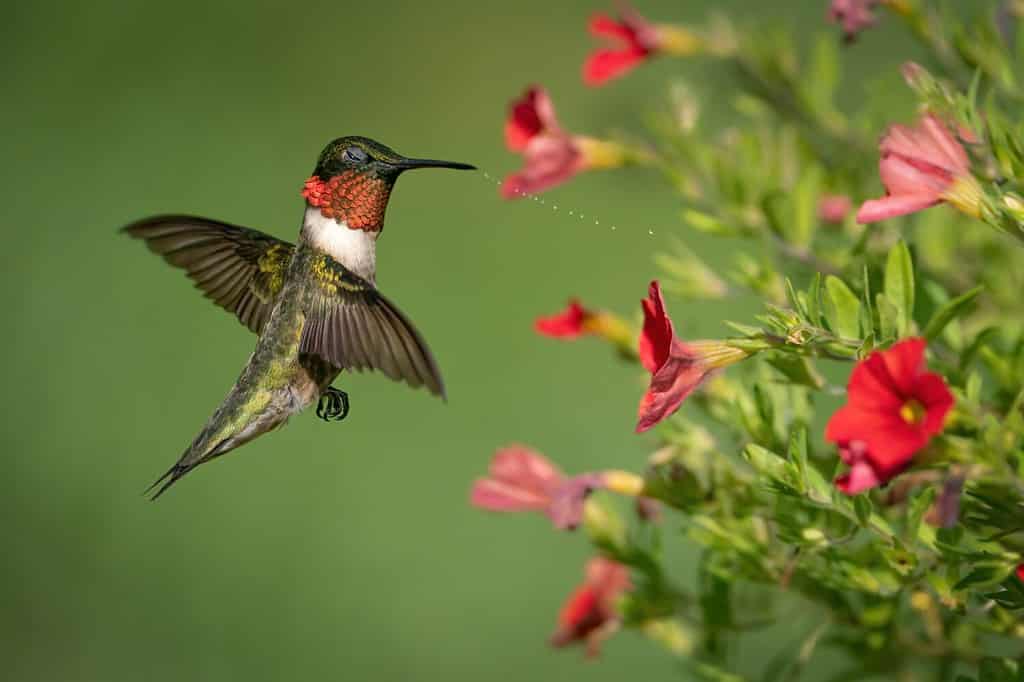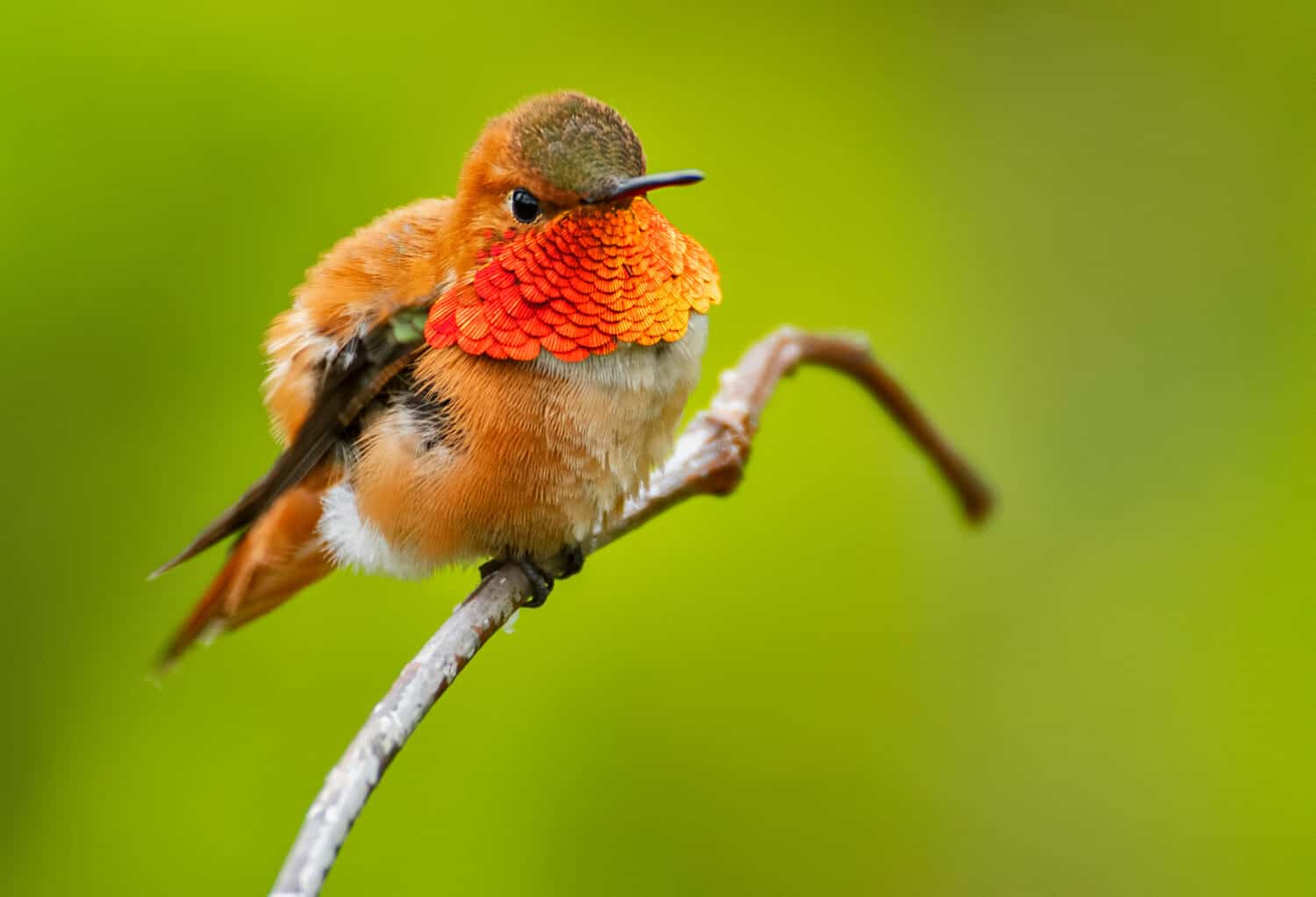Hummingbirds start to fill Pennsylvania’s skies around late April or early May. In fact, most Pennsylvania residents associate the arrival of hummingbirds with the first bloom of blue flowers known as vinca. These birds migrate to the United States to raise their offspring in a more temperate climate. The most common hummingbird species in Pennsylvania is the ruby-throated hummingbird, notorious for its bright red throat patch. But when do hummingbirds leave Pennsylvania? Continue ready to find out everything you need to know about these birds and their migration patterns.
When Do Hummingbirds Leave Pennsylvania?
Hummingbird species that choose to spend their summers in Pennsylvania usually arrive in April and leave by September or October. However, their arrival and departure times vary as migration is not done as a group, so individuals may arrive early or leave late. While in the state, these birds are often seen flying from flower to flower in search of nectar. Furthermore, hummingbirds are drawn to feeders, which provide them with a reliable food source during the warmer months. While they are mostly solitary birds, they can congregate in a small group called a charm.
These gatherings mainly occur around an abundance of food. For example, a well-stocked feeder or rich nectar source. While these birds primarily occur in areas with fields of flowers, they also inhabit meadows, woodlands, and gardens across Pennsylvania.

Hummingbird species that choose to spend their summers in Pennsylvania usually arrive in April and leave by September or October.
©John L. Absher/Shutterstock.com
Where Do Hummingbirds Go When They Leave Pennsylvania?
As hummingbirds migrate individually, there are several areas they flee to during winter. For example, some will spend the colder months along the Gulf Coast and the outer banks of North Carolina. However, most of them fly around the Gulf to southern Mexico and Panama. After the migration, sightings of hummingbirds in Pennsylvania are rare, but there are some stragglers and old or injured individuals who are not strong enough to migrate.
How Long Does it Take Humming Birds to Migrate South?
Migrating is no easy task. In fact, hummingbirds start to prepare for their taxing migration by gaining around 25 to 50% of their body weight by eating more nectar from flowering plants and feeders. Additionally, these birds catch more insects for protein. As a result, hummingbirds have enough fuel to make the long journey south. Therefore, don’t be surprised if you see an increase in hummingbirds at your feeder during fall from September to October; they are stocking up.
It takes a hummingbird approximately 63 hours to fly around 1,897 miles to the most distant Mexican border at a speed of 30 mph. However, they also migrate to Panama, which is a distance of about 4,528 miles over land, or 2,149 miles across the Gulf of Mexico, taking around 150 hours.
While some hummingbirds can fly 500 miles non-stop over around 20 hours, others take a more relaxed approach, flying as little as one hour per day. Hummingbirds’ sporadic migration pattern serves a purpose. It ensures that resources are not depleted simultaneously, which is pretty clever.
Types Of Hummingbirds in Pennsylvania
While there are no species of hummingbird that live in Pennsylvania year-round, there are five species that inhabit or pass through the state during summer, including:
- Ruby-throated Hummingbird
- Rufous Hummingbird
- Allen’s Hummingbird
- Calliope Hummingbird
- Black-chinned Hummingbird
Ruby-throated Hummingbird
The male ruby-throated hummingbird has a bright red patch on its throat, also known as a gorget, and boasts several distinctive markings. For example, they have bronze and green feathers along their backs, with light bellies and short legs. Females don’t have a bright red throat. Instead, their gorgets are white with a gray tint. Ruby-throated hummingbirds weigh less than a penny, approximately a tenth of an ounce. Once fully mature, they can measure about 3 inches long.
These birds usually reside in deciduous forests, parks, gardens, wet meadows, and citrus tree groves. Additionally, they like to nest along streams, where insects and flowering plants are abundant. Ruby-throated hummingbirds are omnivores, consuming both insects and nectar. Around 60% of their diets consist of insects like aphids, caterpillars, spiders, and tiny eggs from trees and leaves. However, in Pennsylvania, these hummingbirds primarily feed on wildflowers like bergamot, honeysuckle, salvia, and petunias.

The male ruby-throated hummingbird has a bright red patch on its throat, also known as a gorget, and boasts several distinctive markings.
©Cavan-Images/Shutterstock.com
Rufous Hummingbird
The male Rufous hummingbird has a beautiful red-to-orange patch on its throat and charcoal shades along its back and belly. Females have green backs and rust-colored throats. Many confuse the Rufous hummingbird with Allen’s hummingbird, but the latter is most often orange with greenish outer feathers, while the Rufous hummingbird may have an entirely green back. These tiny birds are about 3 inches long and weigh one to two-tenths of an ounce.
Rufous hummingbirds prefer habitats near deciduous forests or gardens, yards, and parks in urban areas. Females nest near the top of pine, birch, or spruce trees, ensuring they have overhead branches protecting them. These birds feed on insects and nectar but prefer flowers like lilies, heaths, penstemon, and larkspurs. Furthermore, they try to get protein from catching gnats in mid-flight.

The male Rufous hummingbird has a beautiful red-to-orange patch on its throat and charcoal shades along its back and belly.
Image: punkbirdr, Shutterstock
©punkbirdr/Shutterstock.com
Allen’s Hummingbird
Male Allen’s hummingbirds have bright red and orange throats: their backs and head sport shades of green and blue and lighter shades of copper. However, females are completely opposite, with dull shades of green and orange and spotted white and green throat. As mentioned above, the Rufous and Allen’s hummingbirds are very similar in appearance. However, the latter usually have a more consistent shade of orange across the entire body.
Allen’s hummingbirds are compact and rounded. They usually measure 3.5 inches and weigh a tenth of an ounce. These birds are native to the West Coast and prefer to nest in redwood, eucalyptus, and Douglas-firs. On the other hand, males favor open territories. Allen’s hummingbirds consume nectar from flowering plants like sage, twinflowers, gooseberry, and manzanita. And like other species of hummingbirds, they also eat insects for protein.

Male Allen’s hummingbirds have bright red and orange throats: their backs and head sport shades of green and blue and lighter shades of copper.
Image: Keneva Photography, Shutterstock
©Keneva Photography/Shutterstock.com
Calliope Hummingbird
The Calliope hummingbird is primarily green with tints of yellow and blue. Males have a deep magenta throat, while females are more conservative with green backs and white bellies with shades of peach. These tiny hummingbirds are the smallest bird in the USA, measuring 3 inches long, with a hunch that makes them appear even smaller. Calliope hummingbirds like to inhabit cooler mountain regions during mating season. They prefer thickets near streams, mountain meadows, or previously logged forests. Calliope hummingbirds consume nectar from tubular or cup-shaped flowers as they don’t have to compete with larger hummingbirds. Additionally, they also feed on sap wells and catch insects.

The Calliope hummingbird is primarily green with tints of yellow and blue. Males have a deep magenta throat, while females are more conservative with green backs and white bellies with shades of peach.
Image: Tom Reichner, Shutterstock
©Tom Reichner/Shutterstock.com
Black-chinned Hummingbird
Unlike the other hummingbirds in Pennsylvania, the black-chinned hummingbirds have deep black feathers on their throats. However, when the sun hits this black patch, you can see shades of dark purple. Males have dark black backs, while females are greenish-gray. Black-chinned hummingbirds measure around 3 to 3.5 inches and weigh approximately one to two-tenths of an ounce.
These hummingbirds are hardy, and while they prefer tall trees close to water sources, they also thrive in urban areas. Their favorite trees include sycamore, oak, and cottonwood trees. While these birds differ from other hummingbirds in color, they are similar when it comes to diet. Black-chinned hummingbirds feed on flower nectar and insects like spiders.

Unlike the other hummingbirds in Pennsylvania, the black-chinned hummingbirds have deep black feathers on their throats. However, when the sun hits this black patch, you can see shades of dark purple.
Image: rck_953, Shutterstock
©rck_953/Shutterstock.com
The photo featured at the top of this post is © Steve Byland/Shutterstock.com
Thank you for reading! Have some feedback for us? Contact the AZ Animals editorial team.






